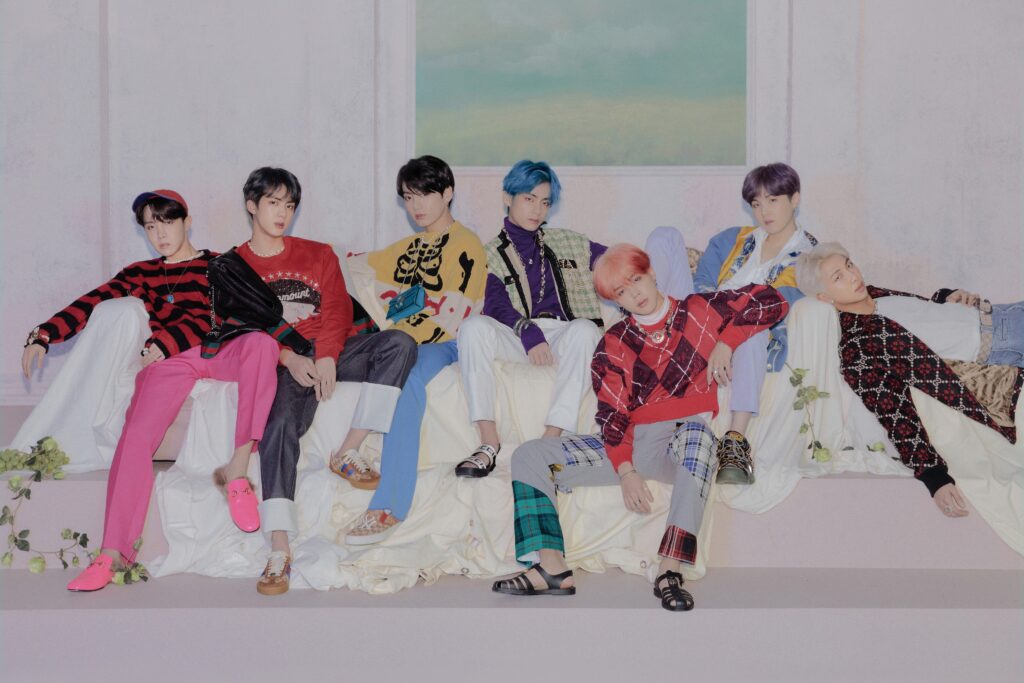Review: Kendrick Lamar’s “To Pimp a Butterfly”
Written by Coog Radio on March 19, 2015

Surprise, surprise! One week before official release, March 23, the cloak has been peeled off to show Kendrick Lamar’s new album “To Pimp a Butterfly” — the cover had been shown as solid black for weeks on iTunes with an untitled track list, which only added to the anticipation. The album cover deemed a black and white image of the White House being overtaken by the black community, a judge with crossed out eyes laid on his side in front of the crowd, and everyone cheering at the audience with stacks of cash and middle fingers in the air. Off the bat, we know this is going to be an outspoken album.
At the bottom of this review, you will the album’s Spotify stream. Listen while reading to get a better grasp on the album. Enjoy!
Track 1: Wesley’s Theory
This song begins the album with sounds of a record player’s light scratches and distant singing of “every n— is a star” that gradually gets clearer and louder. The record player gets abruptly stopped for the real song to start. Funky guitar wobbles and interstellar jingles join the hypnotic, deep-voiced chant of pimping a butterfly. A story and theme is set in this song that further explains the album’s cover and title. Kendrick speaks on “actin’ a fool” when he gets signed by buying everything he wants, putting a “swap meet” of people from his block in Compton in front of the White House and he doesn’t care he’s uneducated because he has that million dollar check. Later in the song, he calls himself out by asking if he actually deserves everything.
Track 2: For Free? – Interlude
Saxophone. Choir. Piano. String Bass. Orchestral jazz band with a spoken poetry style interlude and a repetitive phrase “This d— ain’t free.” He’s talking back to a woman he was involved with, who expects to have him pay everything for her, but like business, he “ain’t free”. Short song, but full of witty lyrics that tap off the tongue poetically.
Track 3: King Kunta
More funky bass, and a character who’s upset that people are sitting in his throne, King Kunta. The reference of Kunta comes from Kunta Kinte, a slave in the late 1700’s who got his leg cut off after trying to escape. In the song, he speaks about these rappers with “ghost writers” who are trying to sit in his throne, which upsets him and makes him want to kill them. He then realizes they are killing each other anyways, so in the end “he ain’t stressing” because he’ll slowly take over while they do the dirty work for him. The chorus speaks about how far he’s gotten “in the game” and everyone wants to cut his legs off, not just to solely stop him but in punishment for escaping. A powerful song with a beat you can’t help but move your feet to (no pun intended) but with a loud message. A sentence is introduced, at the end of the song, as the start of a message or poem that he gradually adds to as the album progresses.
Track 4: Institutionalized
A change in the album eases in and we are now welcomed with a slow patting of a bass drum and tapping of a symbol. A song that sounds more like his music from his first few albums, but still follows the funky style, with a family reference of some wise words from his grandma: “S— don’t change til you get up and wash your ass n—.” Snoop Dogg comes in, as the first artist feature in the album, with a dreamy bridge telling a fairy tale about a boy in Compton who although talented has been institutionalized by the “ghetto”.
Track 5: These Walls
The snapping of fingers catches attention and a sorrowful saxophone follows, with a piano ending it with a frustrated bash of keys. We are zoomed into the song with female moans, and an abrupt utterance of “Sex”. A more sensual, Prince-inspired style song starts but speaks about “if these walls could talk”, a defense mechanism chant. It’s intimacy bangs on your walls.
Track 6: u
The title of this song gives away that it has something to do with the song “i”. As you start the song, the darker theme makes you uneasy as you realize it’s not going to be positive and self-loving like “i”, but in fact, the opposite. A sense of doom hovers over the song, and slowly reveals the character’s hatred and resentment towards others which consumes him so much it leaves him in a hotel room locked up with alcohol to devour him up further, alone with someone named Lucy.
Track 7: Alright
The song starts with a skipping recording of a carol that sounds like a commercial theme song. The previous song had Kendrick Lamar forcing himself to rap through chocked up tears almost, but this song starts with a voice much louder and stronger chanting that everything is going to be alright. This song sounds more like the hip-hop music you’d hear on the radio –saxophone still being his companion — that pumps you up and makes you want to keep going! Pharrell raps the chorus in this song!
Track 8: For Sale? – Interlude
A dreamy song with electronic bells and bubbles, a winded Kendrick catches his breath before going on to talk about meeting Lucy. A reference to the Lucy in the song “u” used again but in a different light, a much sunnier light. She sounds like the perfect girl, opposite to the girl he dumped in “For Free?”, but references to the Bible, pushing daises, Lucy calling even if you love your Father, and signing of a contact are disturbing clues to who Lucy really is.
Track 9: Momma
Initially, you can’t help but wonder who electronically produced this song. Knxwledge, an amazing beatmaker, and Taz Arnold produced this song giving the click-clacks a melody. Otherwise, Kendrick takes the stage and raps about a “feeling brought to you by adrenaline and good rap” which he later tries to understand. He meets a boy that reminds him of himself at that age, which makes him reflect on whether he has progressed since then. The song later speeds up with more energy as Kendrick talks about finding this “feeling” asking “is it in a woman, is it in money, or mankind?”.
Track 10: Hood Politics
We are transported into the “hood”, with a voicemail recording from a friend of Kendrick’s trying to get a hold of Kendrick; in the background, you hear the strumming of a guitar. Scene changes to Kendrick reminiscing to being 14 years old in Compton with descriptions on what was life like at that age and what was important to him, Later, he describes that there’s a new gang in town joining the fight, which furthers the album’s overall theme.
“From Compton to Congress, it’s set trippin’ all around
Ain’t nothin’ new but a flow of new DemoCrips and ReBloodlicans”
Pretty powerful words.
Track 11: How Much a Dollar Cost
Piano keys and tambourine create an opening for this next chapter of an open-ended question. How much a dollar really cost? Kendrick’s interaction with a homeless man asking for a dollar causes him to think about this man’s situation and what is the right thing to do since he feels so entitled to his earnings. As he has this internal battle, it is revealed that the homeless man is more than what he seems.
Track 12: Complexion (A Zulu Love)
A song about skin complexion being a factor in what is deemed beautiful. Powerful song for the destruction of any insecurities over looks in a time of “social branding”. Beauty is in the eye of the beholder.
Track 13: The Blacker the Berry
The first official single of this album — that gave everyone a clue into what Kendrick’s new album had in store — rests as number 13 on the album with heavy bass, a strong beat and even stronger words. Assassin is featured on the song for the chorus, bringing that Jamaican touch to this song, adding to the overall message of black stereotyping. To finally hear this song together with the album only makes more sense of its purpose.
Track 14: You Ain’t Gotta Lie (Momma Said)
Hearing this song brings back the 90’s hip-hop we all love, with a chill melody to sit back and enjoy. Kendrick talks about people who are just talkers who are loud to cover up their insecurities.
Track 15: i
This song got Kendrick Lamar his well-deserved Grammy awards earlier this year for Best Performance and Best Rap Song. It was released before the new album’s official release date was announced and caused anticipating fans to cross their fingers in hopes of a date. The song’s Isley Brothers sampling added to its upbeat, positive message of self-love, opposite to his previous album. A great jam to listen to on a sunny day when you just love being you.
Track 16: Mortal Man
Kendrick Lamar ends his album with a big piece with a big message. Made up of smaller scenes, in the first part, he asks what we’ll do when things “hit the fan”, would we still be a fan? This can be taken literal in two ways, one being more meaningful. Basically, how strong will we be in hard times. The second part completes the message/poem he slowly added onto throughout the album. A message about fighting a war against discrimination together, not against each other. He also admits he’s just a mortal man, maybe just another plain guy. The scene then reveals he was reading the poem out loud to 2Pac during an interview. A fictional conversation between the two made possible with the use of 2Pac’s old 1994 Swedish radio P3 Soul interview. The fictional interview covers the subject of the frustrations the black community have, the rich versus the poor, oppression and revolution. Kendrick reads out loud to 2Pac a friend’s description of the world we live in using a metaphor of a caterpillar’s difficult, almost impossible, transition to a butterfly. He then asks what was 2Pac’s thoughts on it but it ends with Kendrick frantically calling out 2Pac’s name. Unfortunately, we will never know what 2Pac would’ve said.
Rating: 4.7/5
Stream the album below via Spotify or purchase the album on iTunes.
Thanks to RapGenius for the lyrics and background information.
By Hazel Ramos



